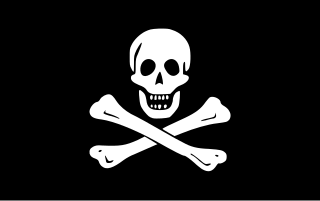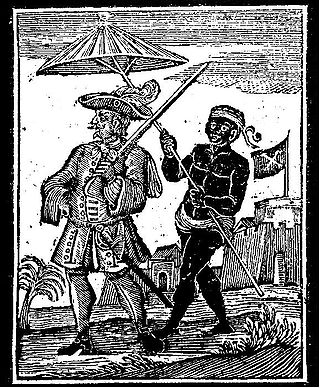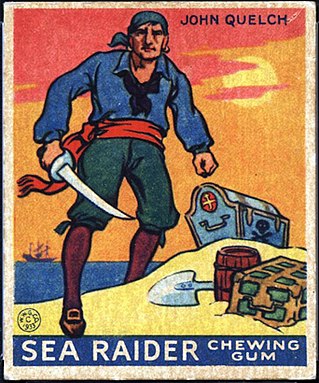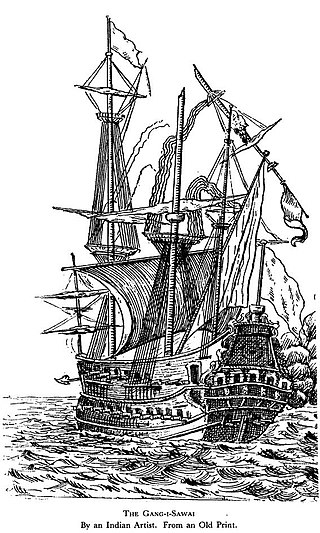See also 1702 in piracy, other events in 1703, 1704 in piracy, and Timeline of piracy.
See also 1702 in piracy, other events in 1703, 1704 in piracy, and Timeline of piracy.

Piracy is an act of robbery or criminal violence by ship or boat-borne attackers upon another ship or a coastal area, typically with the goal of stealing cargo and other valuable goods. Those who conduct acts of piracy are called pirates, vessels used for piracy are pirate ships. The earliest documented instances of piracy were in the 14th century BC, when the Sea Peoples, a group of ocean raiders, attacked the ships of the Aegean and Mediterranean civilisations. Narrow channels which funnel shipping into predictable routes have long created opportunities for piracy, as well as for privateering and commerce raiding.
Captain Samuel Bellamy, later known as "Black Sam" Bellamy, was an English sailor turned pirate during the early 18th century. He is best known as the wealthiest pirate in recorded history, and one of the faces of the Golden Age of Piracy. Though his known career as a pirate captain lasted little more than a year, he and his crew captured at least 53 ships.
Robert Culliford was a pirate from Cornwall who is best remembered for repeatedly checking the designs of Captain William Kidd.

Thomas Tew, also known as the Rhode Island Pirate, was a 17th-century English privateer-turned-pirate. He embarked on two major pirate voyages and met a bloody death on the second, and he pioneered the route which became known as the Pirate Round. Other infamous pirates in his path included Henry Every and William Kidd.

Edward England was an Irish pirate. The ships he sailed on included the Pearl and later the Fancy, for which England exchanged the Pearl in 1720. His flag was the classic Jolly Roger — almost exactly as the one "Black Sam" Bellamy used — with a human skull above two crossed bones on a black background. Like Bellamy, England was known for his kindness and compassion as a leader, unlike many other pirates of the time.

Henry Every, also known as Henry Avery, sometimes erroneously given as Jack Avery or John Avery, was an English pirate who operated in the Atlantic and Indian oceans in the mid-1690s. He probably used several aliases throughout his career, including Benjamin Bridgeman, and was known as Long Ben to his crewmen and associates.

Edward "Ned" Low was a notorious pirate of English origin during the latter days of the Golden Age of Piracy, in the early 18th century. Low was born into poverty in Westminster, London, and was a thief from an early age. He moved to Boston, Massachusetts, as a young man. His wife died in childbirth in late 1719. Two years later, he became a pirate, operating off the coasts of New England and the Azores, and in the Caribbean.
Henry Jennings was an 18th-century English privateer from the colony of Bermuda, who served primarily during the War of the Spanish Succession and later served as leader of the pirate haven or "republic" of New Providence.
The Pirate Round was a sailing route followed by certain, mainly English, pirates, during the late 17th century and early 18th century. The course led from the western Atlantic, parallel to the Cape Route around the southern tip of Africa, stopping at Madagascar, then on to targets such as the coast of Yemen and India. The Pirate Round was briefly used again during the early 1720s. Pirates who followed the route are sometimes referred to as Roundsmen. The Pirate Round was largely co-extensive with the routes of the East India Company ships, of Britain and other nations.

John Bowen was a pirate of Créole origin active during the Golden Age of Piracy. He sailed with other famous contemporaries, including Nathaniel North and George Booth, who was his captain when he was a crewman aboard the Speaker. Over a four-year period, Bowen took about £170,000 in goods and coinage and retired to Bourbon for a brief period of time before his death in 1704.
See also 1703 in piracy, other events in 1704, 1705 in piracy, and Timeline of piracy.

John Quelch was an English pirate who had a lucrative but very brief career of about one year. His chief claim to historical significance is that he was the first person to be tried for piracy outside England under Admiralty Law and thus without a jury. These Admiralty courts had been instituted to tackle the rise of piracy in colonial ports where civil and criminal courts had proved ineffective.

Nathaniel North was supposed to have been a Bermuda-born pirate during the Golden Age of Piracy, operating in the Indian Ocean under John Bowen and then as captain of the Defiant following Bowen's retirement in 1704. After losing the Defiant he ruled a pirate colony at Ambonaivo made up of his former crew before returning to sea. Retiring with great wealth in 1709, North settled in Madagascar and married a local woman, but was murdered by her family.

Thomas Howard was a pirate primarily active in the Indian Ocean and the Red Sea during the Golden Age of Piracy. He served under other pirates of the time, including George Booth and John Bowen. He also commanded the 36-gun Prosperous. He later retired to Rajapur, in India, where he married a local woman. He was later murdered by her relatives.

The Ganj-i-Sawai was an armed Ghanjah dhow belonging to the Mughals. During Aurangzeb's reign, it was captured on 7 September 1695 by the English pirate Henry Every en route from present-day Mocha, Yemen to Surat, India. It was built on the order of Empress Mariam-uz-Zamani, great grandmother of Aurengzeb, after the capture of her ship named Rahimi.

Piracy was a phenomenon that was not limited to the Caribbean region. Golden Age pirates roamed off the coast of North America, Africa and the Caribbean.
Robert Colley was an English pirate and privateer active near Newfoundland and the Indian Ocean.

The Flying Gang was an 18th-century group of pirates who established themselves in Nassau, New Providence in the Bahamas after the destruction of Port Royal in Jamaica. The gang consisted of the most notorious and cunning pirates of the time, and they terrorized and pillaged the Caribbean until the Royal Navy and infighting brought them to justice. They achieved great fame and wealth by raiding salvagers attempting to recover gold from the sunken Spanish treasure fleet. They established their own codes and governed themselves independent from any of the colonial powers of the time. Nassau was deemed the Republic of Pirates as it attracted many former privateers looking for work to its shores. The Governor of Bermuda stated that there were over 1,000 pirates in Nassau at that time and that they outnumbered the mere hundred inhabitants in the town.
Josiah Raynor (1665–1743) was a pirate active in the Red Sea. Before he was briefly a pirate captain, he was a sailor on the Batchelor’s Delight on which he sailed alongside William Dampier.
Thomas White was an English pirate active in the Caribbean and the Indian Ocean. He was only briefly a captain on his own, but served under several more prominent captains such as George Booth, John Bowen, Thomas Howard, John Halsey, and Nathaniel North.